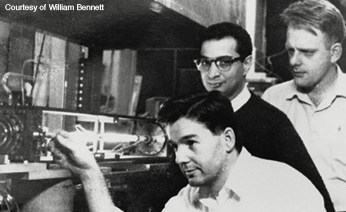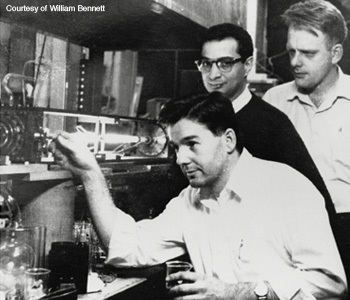
Helium-Neon (HeNe) Lasers are renowned for their excellent beam quality and reliability in continuous-wave (CW) operation, making them a staple in application like spectroscopy, holography, and interferometry. For professionals selecting a laser source, understanding HeNe laser technolgoy and specifications is key to choosing the right solution. This article explores the fundamentals of HeNe lasers, the history of their development, and critical considerations for selecting the ideal HeNe laser.
How HeNe Lasers Work: Technology and Operation
A helium-neon (HeNe) laser is a continuous-wave gas laser using a 10:1 mixture of helium and neon pressurized within a glass tube. When a DC current is applied to electrodes at opposite ends, helium atoms are excited into metastable states, efficiently transferring energy to neon atoms with similar excitation energies. This process enables multiple laser transitions due to neon’s varied energy levels.
Versatile Wavelength Options for HeNe Lasers
The most common HeNe laser wavelength is 632.8 nm (red), but transitions at 543.5 nm (green), 594 nm (yellow), 612 nm (orange), and 3.39 µm (MWIR) are achievable using resonator mirrors with wavelength-specific coatings. Modern HeNe lasers are compact (15–50 cm tube length), deliver milliwatt-level output (0.5–20 mW), and offer superior beam quality (TEM00), a significant improvement over early models requiring 15 m tubes for 150 mW output.
Evolution of HeNe Lasers: A Historical Breakthrough

Pioneering HeNe Laser Development at Bell Labs
The first HeNe laser was developed in 1960 at Bell Labs by Ali Javan, William Bennet Jr., and Donald Herriott. Despite challenges like melting laser tubes and damaged mirror coatings, the team persevered. On a snowy December day in 1960, after numerous failed tests, Herriott’s meticulous mirror alignment achieved a stable infrared (IR) output at 1153 nm, marking the first CW gas laser.
Achieving the Iconic 632.8 nm HeNe Laser
The initial IR emission at 1153 nm had limited demand, prompting further research. By 1962, Javan’s team developed the now-iconic 632.8 nm red HeNe laser, meeting the need for visible-spectrum lasers. Subsequent work by Alan White and Dane Rigden at Bell Labs enhanced stability and output power by adopting a hot-filament direct-current discharge, revealing a new metastable helium state that enabled reliable 632.8 nm emission.
Key Considerations for Choosing a HeNe Laser
When selecting a HeNe laser, professionals must evaluate wavelength, output power, beam quality, and customization options to match their application’s needs. Here are the critical factors:
1. Wavelength Selection for Specific Applications
HeNe lasers offer multiple wavelengths, with 632.8 nm (red) being the most common for spectroscopy and holography, while 543.5 nm (green) and 594 nm (yellow) suit specialized imaging and alignment tasks.
RPMC Solution: RPMC’s HeNe lasers are available in 632.8 nm, 543.5 nm, and 594 nm, ensuring versatility for applications like interferometry and medical diagnostics.
2. Beam Quality and Output Power
HeNe lasers are prized for their excellent TEM00 beam quality, critical for precision applications. Output powers range from 0.5 mW to 20 mW, sufficient for most laboratory and industrial uses, unlike early models with lower efficiency.
RPMC Solution: Our HeNe lasers deliver superior beam quality and stable outputs up to 20 mW, ideal for holography, spectroscopy, and alignment tasks.
3. Customization and Integration Options
HeNe lasers must integrate seamlessly into lab or OEM systems. Options like single-mode or multimode operation, random or linear polarization, Brewster window tubes, and fiber coupling enhance flexibility. Power supply choices (laboratory or OEM versions) further support integration
RPMC Solution: RPMC offers customizable HeNe lasers with single-mode, multimode, fiber-coupled, and other configuration options, tailored for applications from classroom demonstrations to telecommunications.
4. Longevity and Reliability
HeNe lasers offer service lives up to 30,000 hours, with low noise and high stability, making them a cost-effective choice for applications requiring consistent performance. While diode lasers are gaining ground in industrial settings, HeNe’s beam quality ensures its relevance.
RPMC Solution: Working closely with our manufacturing partner, RPMC provides HeNe lasers with robust mechanical designs and long lifetimes, backed by decades of manufacturing expertise.
Why Choose HeNe Lasers from RPMC?
HeNe lasers remain essential for applications demanding superior beam quality and reliability, includiing spectroscopy, interferometry, holography, and telecommunications. RPMC Lasers, along with our trusted partners, offers high-quality HeNe lasers in 632.8 nm, 543.5 nm, and 594 nm, with customizable options for lab and OEM applications. With up to 39k hours of service life and excellent TEM00 beam quality, our CW HeNe gas lasers meet the needs of researchers and engineers.
Ready to Select Your HeNe Laser?
Choosing the right HeNe laser depends on your application’s wavelength, power, and integration requirements. RPMC’s HeNe lasers, including 632.8 nm, 543.5 nm, and 594 nm options, deliver precision and reliability. Contact our team at [email protected] or click below to discuss solutions with our experts.
Have questions?

 BUY NOW
BUY NOW 
